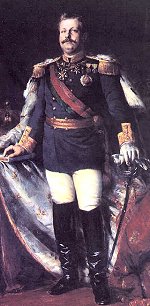Charles I (Portugal)
Charles I ( Portuguese : Dom Carlos Fernando Luís Maria Victor Miguel Rafael Gabriel Gonzaga Xavier Francisco de Assis José Simão de Bragança Sabóia Bourbon Saxe-Coburgo-Gotha ) (born September 28, 1863 in Lisbon ; † February 1, 1908 ibid) was the penultimate king of Portugal and the Algarve . He came from the Portuguese branch of the House of Saxe-Coburg and Gotha and ruled from 1889 until his death in an assassination attempt by Republicans in 1908.
Life
Karl was the eldest son of King Ludwig I of Portugal and his wife Maria Pia of Savoy . He was interested in many things, particularly deep-sea science. Politically, however, he had little talent.
His rule was marked by a rapid loss of prestige for the Portuguese state in general and the monarchy in particular. With the Treaty of Windsor (1899) Portugal had to finally bury its plan to combine its two colonies (now Angola and Mozambique ) in southern Africa in order to establish a large, coherent colonial empire . Portugal had to give in to British pressure, because the British had similar plans for the African continent in a north-south direction, i.e. a connection of their colonies from Egypt to South Africa . The Treaty of Windsor allowed Portugal to consolidate its holdings in southern Africa, but the Portuguese public perceived this development as a great defeat. The plan to found a cohesive colonial empire in southern Africa had sparked a wave of nationalist enthusiasm, and so was the disappointment when Portugal had to bow to British pressure. For the first time, the weakness of the country was blamed not only on the government, but on the monarchy itself.
In addition, there were serious economic problems that led to national bankruptcy in 1891 , which resulted in a further serious loss of reputation for the monarchy. Domestic political conditions were partly chaotic. The divided monarchists were no longer in a position to stop the steady growth of the republican and socialist currents.
The desperate king appointed João Franco Prime Minister. He tried first to pursue a moderate policy towards the Republicans. When this was unsuccessful, the Prime Minister switched to a tough pace and persecuted the Republicans through press censorship , and eventually even deportation to the colonies. These tough policies led to a further growth in Republicans and hatred of the monarchy. On February 1, 1908, the carriage in which the king and the heir to the throne, his son Ludwig Philipp , were traveling, were fired at the Praça do Comércio in Lisbon. The king died immediately as a result of the attack, and his son died 20 minutes later from his injuries. Both are buried in the São Vicente de Fora monastery . The king's younger son, Emanuel II , was the last monarch to ascend the Portuguese throne.
Marriage and offspring
Karl had married Princess Amélie of Orléans as heir to the throne in 1886 . She was a daughter of Louis Philippe of Orleans , the French pretender to the throne , in turn, a grandson of the last French king Louis-Philippe I was.
He had three children with her:
- Ludwig Philipp (born March 21, 1887 - † February 1, 1908)
- Maria Anna (* / † December 14, 1887)
- Manuel II (November 15, 1889 - July 2, 1932), King of Portugal
In addition, Maria Pia von Sachsen-Coburg-Gotha and Braganza claimed since 1957 to be his illegitimate daughter and to continue the line of the Portuguese Wettins.
ancestors
| Pedigree of Charles I, King of Portugal (1889–1908) | ||||||||
|---|---|---|---|---|---|---|---|---|
| Great-great-grandparents |
Duke Franz von Sachsen-Coburg-Saalfeld |
Count |
|
Emperor |
Prince Karl Emanuel of Savoyen-Carignan |
Grand Duke Ferdinand III. of Tuscany |
Emperor |
Prince Karl Emanuel of Savoyen-Carignan |
| Great grandparents |
Prince |
|
King |
Archduke |
||||
| Grandparents |
|
King |
||||||
| parents |
|
|||||||
See also
Web links
| predecessor | Office | successor |
|---|---|---|
| Ludwig I. |
King of Portugal 1889–1908 |
Manuel II |
| personal data | |
|---|---|
| SURNAME | Charles I. |
| ALTERNATIVE NAMES | Carlos Fernando Luís Maria Victor Miguel Rafael Gabriel Gonzaga Xavier Francisco de Assis José Simão de Bragança Sabóia Bourbon Saxe-Coburgo-Gotha (full name, Portuguese) |
| BRIEF DESCRIPTION | King of Portugal |
| DATE OF BIRTH | September 28, 1863 |
| PLACE OF BIRTH | Lisbon |
| DATE OF DEATH | February 1, 1908 |
| Place of death | Lisbon |


